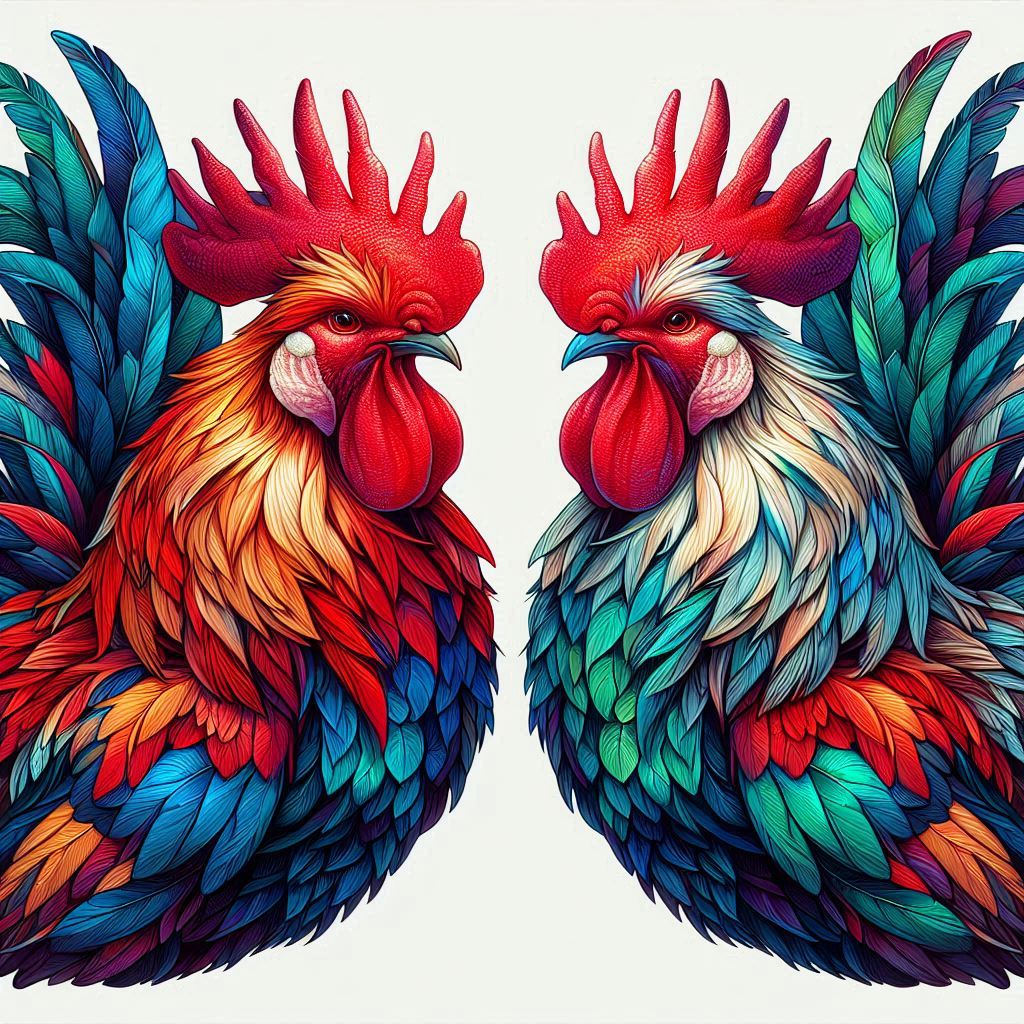Natural Instincts: The Rooster’s Drive to Dominate
 Each rooster’s primary goal is to establish dominance. This drive to dominate isn’t just a random occurrence—it’s a critical survival mechanism deeply embedded in their behavior. Using claiming territory and asserting control, a rooster ensures access to ample resources and prime breeding opportunities. This trait has been honed through generations of natural selection, ensuring that the fittest birds remain at the forefront. The aggressive nature of roosters is not merely
Each rooster’s primary goal is to establish dominance. This drive to dominate isn’t just a random occurrence—it’s a critical survival mechanism deeply embedded in their behavior. Using claiming territory and asserting control, a rooster ensures access to ample resources and prime breeding opportunities. This trait has been honed through generations of natural selection, ensuring that the fittest birds remain at the forefront. The aggressive nature of roosters is not merely
for personal gain; it serves a vital role in the social structure of the flock. Roosters act as the guardians of hens and chicks, and part of their aggression is directed at ensuring any potential threats are swiftly neutralized. This fierce protective instinct is a crucial aspect of what makes them such tenacious combatants.
A rooster’s dominance is displayed through various behaviors such as crowing, posturing, and sometimes engaging in physical confrontations. Crowing is not just a wake-up call for the farm; it’s a vocal assertion of territory and status. By crowing, a rooster announces his presence and warns other males to stay away. This vocalization can be heard over long distances, serving as a deterrent to rivals and a call to potential mates.
Posturing involves the rooster puffing up his feathers, standing tall, and spreading his wings to appear larger and more intimidating. This display is often enough to ward off other roosters without the need for actual combat. However, when two roosters do engage in a fight, it is typically a fierce battle, as each bird uses his sharp spurs and beak to assert dominance.
Physical Traits: Built for Battle
Roosters come equipped with an arsenal of physical traits designed to give them the upper hand in skirmishes. Let’s break it down into some critical components:
- Spurs: these are the rooster’s equivalent of a knight’s lance. Spurs are sharp, keratinized projections on the back of their legs, used to inflict serious damage during fights.
- Wattle and Comb: while seemingly decorative, these fleshy structures are indicators of a rooster’s health and fitness. a large, vibrant comb signals a strong, capable opponent.
- Musculature: roosters possess strong neck and leg muscles, essential for delivering powerful blows. Their muscular build is optimized for short, intense bursts of energy, making them formidable adversaries in combat.
Genetic Traits
Certain genes are directly linked to aggression in roosters. Breeders have long been aware of this and have selectively bred birds that display the highest levels of tenacity and combativeness. This deliberate selection process enhances the natural aggression levels, making each subsequent generation potentially more pugnacious and formidable.
Genetics doesn’t just influence behavior; it also plays a crucial role in developing the physical attributes that make roosters effective fighters. Roosters bred for fighting often exhibit more prominent spurs, larger combs, and more robust physiques. These physical characteristics are not accidental but are the result of careful selective breeding aimed at enhancing the birds’ fighting capabilities.
Prominent spurs, for example, are vital in physical confrontations. These sharp, claw-like structures on the back of a rooster’s legs are used as weapons during fights. Larger combs and wattles are often associated with higher testosterone levels, which correlate with increased aggression and competitiveness. A robust physique, with strong muscles and a sturdy frame, gives a rooster an advantage in both defense and offense.
Selective breeding has amplified these traits over generations, leading to roosters that are not only more aggressive but also better equipped for combat. The process involves choosing birds that exhibit the desired traits most strongly and using them as breeding stock. This focus on specific genetic attributes ensures that each new generation inherits these enhanced qualities.
Psychological Aspects
Roosters naturally establish pecking orders within their social groups, leading to frequent conflicts as they compete for the top position. This quest for dominance isn’t merely a display of brute force; it’s a complex psychological battle. The rooster’s mindset is constantly focused on testing and asserting its position within the social hierarchy.
Testosterone levels play a significant role in driving a rooster’s aggressive behavior. Elevated levels of testosterone not only increase aggression but also boost confidence. This hormone fuels the psychological need to engage in fights and assert dominance over rivals.
Within the flock, roosters use various tactics to establish and maintain their dominance. Posturing, vocalization, and physical confrontations are all part of their arsenal. Each interaction serves as a test of strength and resolve, with the dominant rooster emerging victorious and reinforcing its status within the group.
The psychological dynamics of dominance extend beyond mere aggression. Dominant roosters often exhibit behaviors associated with leadership, such as directing the movements of the flock and taking charge during potential threats. This leadership role is not just about physical strength but also about psychological dominance and the ability to influence others.
Roosters that successfully assert their dominance experience a sense of satisfaction and fulfillment, reinforcing their aggressive behavior patterns. Conversely, those who fail to establish dominance may experience stress and anxiety, leading to further aggressive displays in an attempt to regain control.
Environmental Triggers
The environment in which a rooster is raised and lives can influence its aggression levels.
Crowded conditions, lack of resources, or abrupt changes in their environment can heighten a rooster’s aggression. When birds are stressed, the likelihood of fights breaking out skyrockets. Understanding the environmental stresses can be crucial for managing and anticipating aggressive behavior.
Roosters raised in isolation or without the presence of other roosters can develop higher levels of aggression when eventually introduced to others. The lack of social interaction can result in poorly developed social skills and heightened aggressiveness under new social dynamics.
Managing Rooster Aggression
If you own or work with roosters, knowing how to manage their aggression is vital.
Ensure that roosters have ample space to establish their territories. Lack of sufficient space can exacerbate conflicts and stress.
Introducing new roosters to an established group should be done gradually and carefully. Slow integration can help manage and reduce conflicts.
Providing a stimulating environment with adequate resources, like food and water, can help keep roosters occupied and reduce unnecessary aggression.
